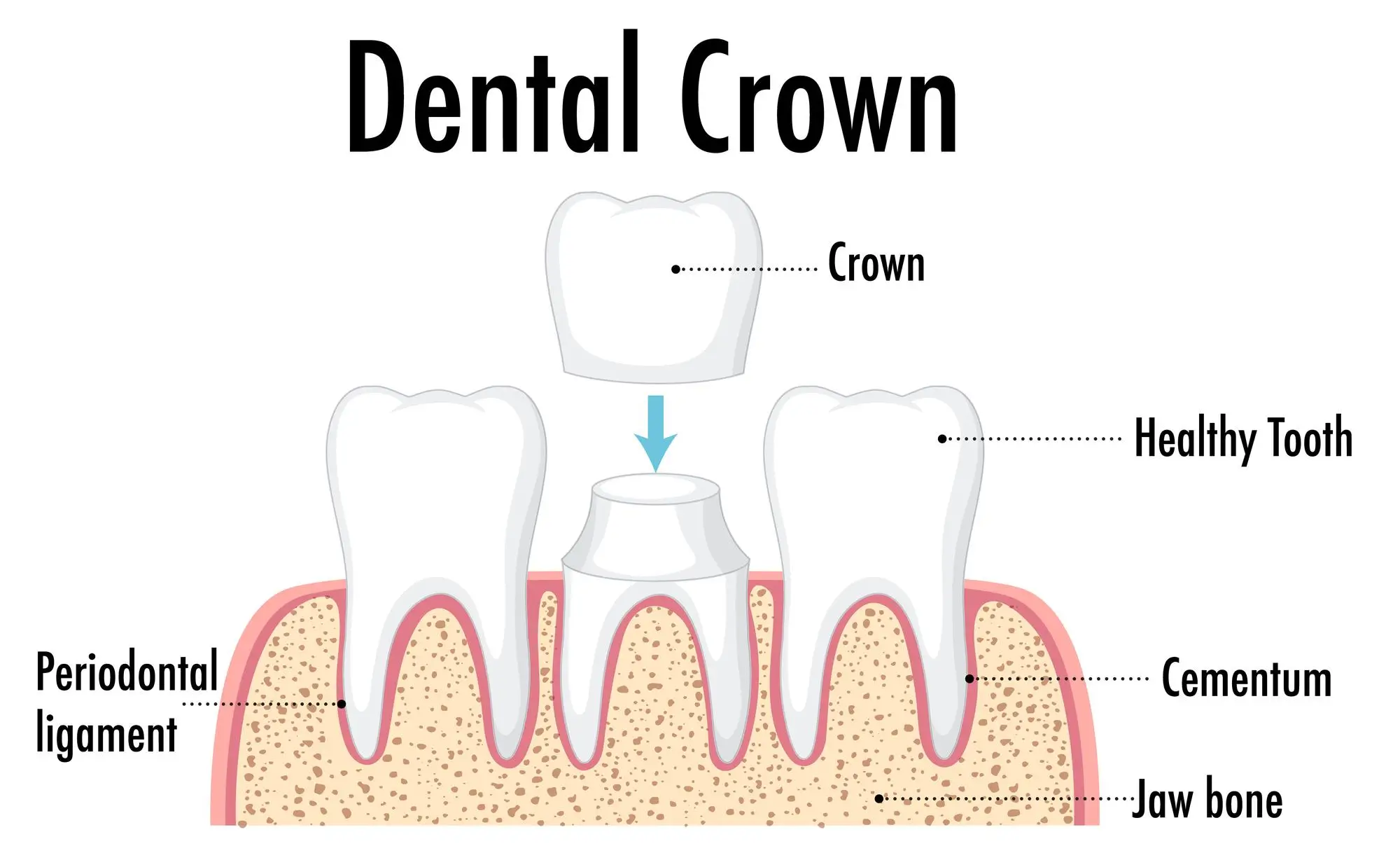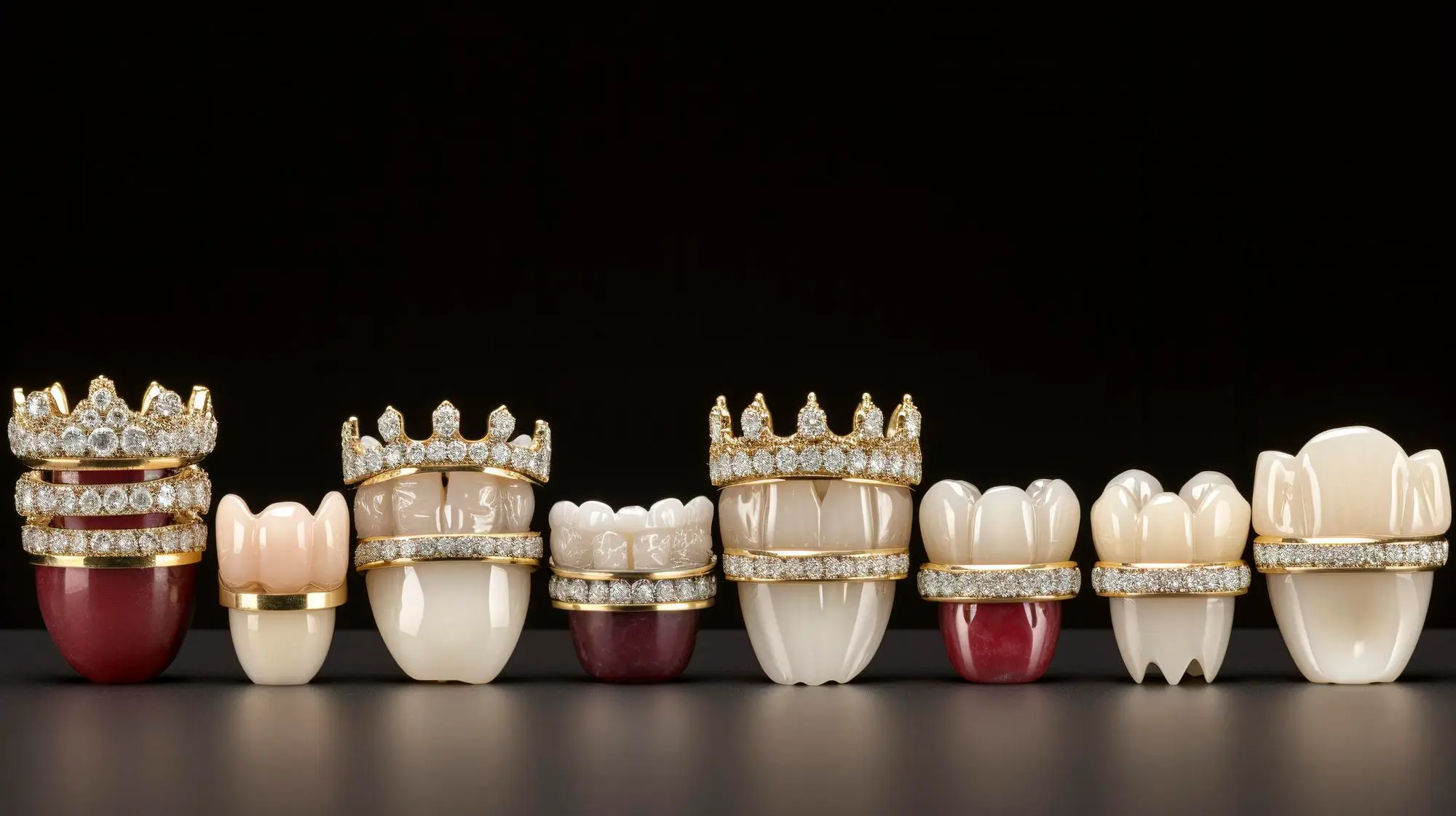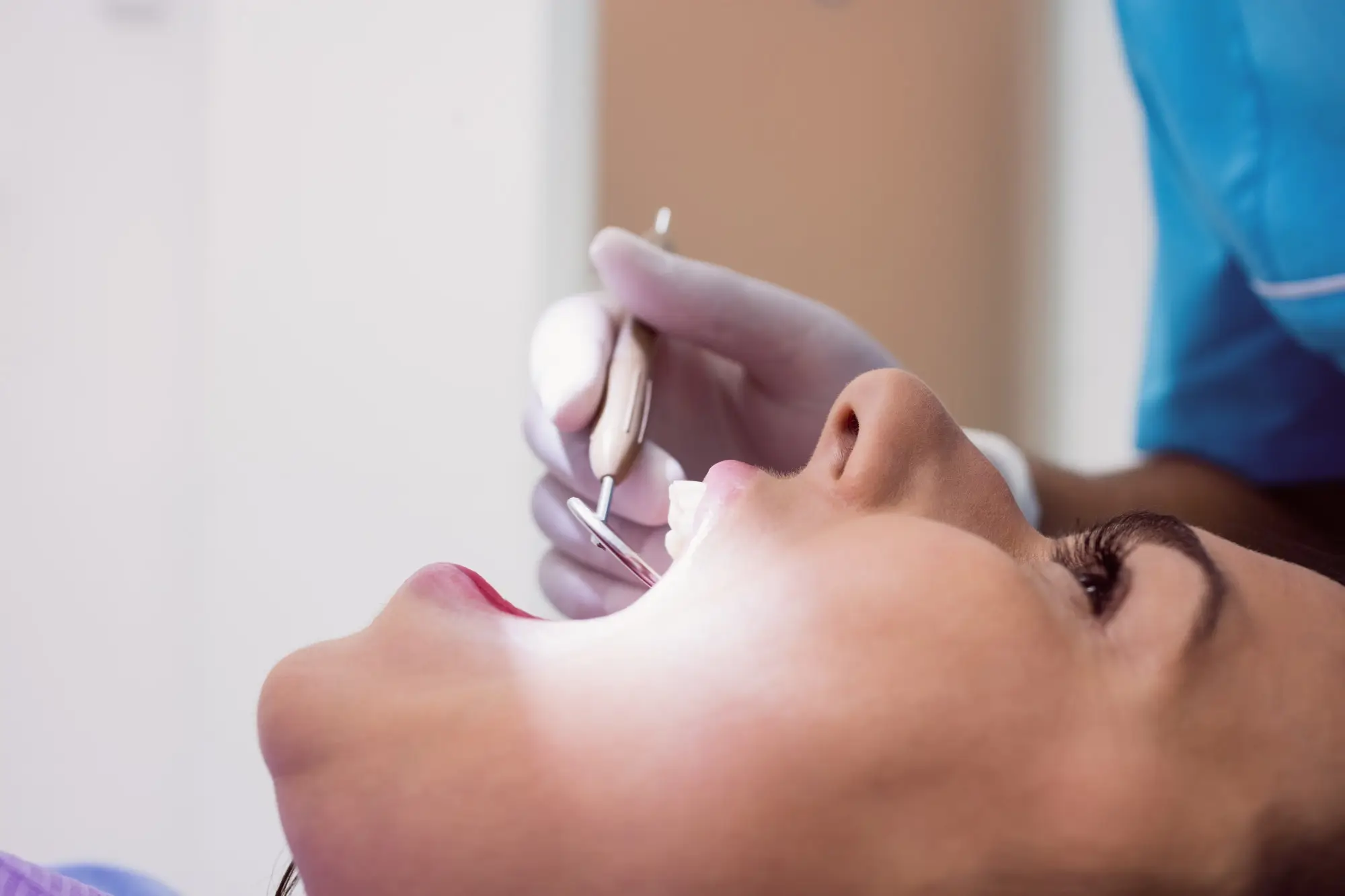What are modern dental crown techniques and methods used in dentistry? What is their difference from other traditional types of dental crowns? Cost considerations and Aesthetics are the things we will talk about in this article. So be with us.
Introduction to Dental Crowns
Dental crowns services are essential restorative solutions used to repair and strengthen damaged or compromised teeth. This section provides an overview of dental crowns, emphasizes the importance of selecting the appropriate technique, and introduces the various crown techniques available.
Overview of Dental Crowns
Dental crowns, often referred to as caps, are prosthetic devices placed over a tooth to restore its shape, size, strength, and improve its appearance. They encapsulate the visible portion of a tooth above the gum line, providing protection and support while resembling the natural tooth structure. Crowns are commonly recommended for teeth with extensive decay, large fillings, fractures, or after root canal treatment to restore functionality and aesthetics.
Importance of Choosing the Right Technique
Selecting the appropriate crown technique is crucial for ensuring optimal outcomes in terms of aesthetics, durability, and patient satisfaction. Different techniques offer varying benefits in terms of strength, aesthetics, biocompatibility, and cost. Understanding these differences is essential for both dental practitioners and patients seeking the best treatment option for their specific needs.
Brief Introduction to Different Crown Techniques
In this section, we’ll briefly introduce the primary crown techniques discussed in detail throughout this blog. These techniques include traditional methods such as metal crowns and porcelain-fused-to-metal (PFM) crowns, as well as modern advancements like all-ceramic, zirconia, and E-max crowns. Each technique has distinct characteristics that influence its suitability for different clinical scenarios and patient preferences.
For more information or cosulting about dental crowns, You can contact us.
Traditional Dental Crown Techniques
Traditional dental crown techniques form the bedrock of modern dental restoration, offering a diverse array of options that balance durability, aesthetics, and functional longevity. This section explores in detail four primary traditional crown techniques: conventional metal crowns, porcelain-fused-to-metal (PFM) crowns, all-ceramic crowns, and gold crowns.

Conventional Metal Crowns
Conventional metal crowns have stood the test of time due to their exceptional durability and strength. Typically crafted from alloys such as gold, platinum, or base metals like nickel-chromium, these crowns are renowned for their ability to withstand the heavy chewing forces exerted on molars and premolars. The metallic composition provides robustness, making them a reliable choice for posterior teeth where strength is paramount. Despite their historical use, advancements in dental materials and techniques have enhanced the aesthetics of metal crowns, reducing their conspicuousness and expanding their applicability across various dental restorations.
Metal crowns are preferred for their longevity and minimal wear to opposing teeth, attributes that contribute to their enduring popularity among dentists and patients seeking durable dental solutions. The biocompatibility of gold and other alloys further enhances their appeal, ensuring minimal risk of allergic reactions or adverse tissue responses. Although traditionally more noticeable than their ceramic counterparts, modern techniques have refined metal crowns to blend more seamlessly with natural teeth, meeting both functional and aesthetic expectations.
Porcelain-Fused-to-Metal (PFM) Crowns
Porcelain-fused-to-metal (PFM) types of dental crowns represent a significant advancement in dental technology, combining the strength of metal with the aesthetic appeal of porcelain. These crowns feature a metal substructure that provides structural integrity and durability, coupled with a porcelain exterior that mimics the natural color and translucency of teeth. The porcelain layer is carefully matched to the patient’s existing teeth, ensuring a seamless blend that enhances smile aesthetics.
PFM crowns are highly versatile, suitable for both anterior and posterior teeth restorations where durability and aesthetic appearance are essential considerations. They offer excellent longevity when properly cared for, often lasting ten to fifteen years or more before requiring replacement. This durability makes them a popular choice among dentists for restoring damaged or weakened teeth, particularly in cases where both strength and natural appearance are priorities.
Advancements in porcelain technology have further refined PFM crowns, reducing the occurrence of porcelain chipping or wear while maintaining their cosmetic appeal. Patients benefit from the dual benefits of metal strength and porcelain aesthetics, enjoying restored dental function and improved smile aesthetics that boost confidence and overall oral health.
All-Ceramic Crowns
All-ceramic crowns have revolutionized cosmetic dentistry with their superior aesthetics and biocompatibility. Crafted from advanced ceramic materials such as porcelain or zirconia, these crowns closely mimic the natural translucency and color variations of teeth. They are prized for their ability to create a lifelike appearance that blends seamlessly with surrounding natural teeth, making them an ideal choice for front teeth restorations where aesthetics are paramount.
The popularity of all-ceramic dental crown types stems from their aesthetic superiority and biocompatibility, offering patients a natural-looking smile without compromising on strength or durability. Unlike metal-based crowns, ceramic crowns do not conduct heat or cold, providing a more comfortable experience for patients with sensitivity concerns. Their resilience to staining and wear ensures long-term aesthetic appeal, maintaining a bright and natural smile for years following placement.
Modern advancements in ceramic technology have further enhanced the strength and durability of all-ceramic crowns, making them suitable for a broader range of dental applications. Dentists often recommend these crowns for patients seeking cosmetic enhancements or those with metal allergies, ensuring compatibility with diverse patient needs and preferences. Whether used for single-tooth restorations or full-mouth rehabilitations, all-ceramic crowns deliver exceptional results that blend aesthetics with functionality, supporting optimal oral health outcomes for patients of all ages.
Gold Crowns
Gold crowns are one of the dental crown types. Although less prevalent in contemporary dental practice, they remain a benchmark for durability and longevity. Crafted from gold alloys, these crowns offer unparalleled strength and biocompatibility, making them a preferred choice for posterior teeth where durability is paramount. Gold crowns exhibit minimal wear to opposing teeth and are exceptionally gentle on natural tooth structure, reducing the risk of abrasion or damage over time.
The distinctive properties of gold, including its malleability and adaptability during placement, ensure a precise fit that enhances comfort and long-term performance. While their metallic appearance may deter some patients seeking discreet dental restorations, gold crowns continue to attract individuals seeking durable and reliable solutions for restoring damaged or compromised teeth. Dentists value gold crowns for their longevity and minimal maintenance requirements, providing patients with lasting dental benefits that support overall oral health and function.
Modern Dental Crown Techniques
Modern dental crown techniques represent the forefront of dental innovation, leveraging advanced materials and technologies to enhance both aesthetics and functionality. This section explores four cutting-edge types of dental crown techniques: zirconia crowns, E-Max crowns, CAD/CAM technology in crown fabrication, and 3D printing in dentistry.
Read it: Biomimetic Applications in Dental Crowns
Zirconia Crowns
Zirconia crowns (one of the modern dental crown types) have revolutionized dental restoration with their exceptional strength and aesthetic appeal. Zirconia, a type of ceramic material, is renowned for its durability and biocompatibility, making it an ideal choice for dental crowns. These crowns are crafted using computer-aided design (CAD) and computer-aided manufacturing (CAM) technology, ensuring precise fit and superior aesthetics.
Zirconia crowns offer several advantages over traditional materials, including enhanced fracture resistance and a natural appearance that closely resembles natural teeth. Their translucent quality allows light to pass through similarly to natural enamel, providing a lifelike appearance that blends seamlessly with surrounding teeth. Zirconia crowns are suitable for both anterior and posterior teeth restorations, offering patients durable solutions that withstand daily wear and tear while preserving smile aesthetics.
E-Max Crowns
E-Max crowns are another innovative option in modern dentistry, crafted from lithium disilicate ceramic. These crowns are prized for their strength, durability, and aesthetic properties, making them an ideal choice for patients seeking natural-looking restorations. E-Max crowns are known for their high translucency and ability to reflect light similarly to natural teeth, creating a vibrant and lifelike smile.
The manufacturing process of E-Max crowns involves CAD/CAM technology, ensuring precise fabrication and customization to each patient’s unique dental anatomy. This precision allows for minimal tooth preparation, preserving more natural tooth structure compared to traditional dental crown techniques. E-Max crowns are highly biocompatible and resistant to chipping and cracking, providing patients with long-lasting dental solutions that enhance both function and appearance.
CAD/CAM Technology in Crown Fabrication
Computer-aided design (CAD) and computer-aided manufacturing (CAM) technology have revolutionized crown fabrication, streamlining the process and enhancing precision. CAD/CAM technology allows dental professionals to create digital impressions of a patient’s teeth and design crowns digitally with meticulous detail. These digital designs are then sent to a milling machine that fabricates the crown from a solid block of ceramic or composite material.
The integration of CAD/CAM technology in crown fabrication offers several benefits, including improved accuracy, reduced chairside time, and enhanced patient comfort. Digital impressions eliminate the need for messy traditional impressions, improving patient experience and ensuring precise fit and function of crowns. CAD/CAM crowns are known for their high-quality craftsmanship and aesthetic consistency, meeting the demands of modern dental aesthetics and functional requirements.

3D Printing in Dentistry
3D printing has emerged as a transformative technology in dentistry, offering new possibilities in crown fabrication and dental prosthetics. This advanced manufacturing technique allows for the creation of intricate dental restorations directly from digital designs, eliminating many of the limitations of traditional manufacturing processes.
In dental applications, 3D printing enables rapid prototyping and customization of crowns and prosthetics with unprecedented accuracy and efficiency. Dental laboratories and clinics utilize 3D printers to produce crowns, bridges, and other dental appliances with precise fit and minimal material waste. This technology facilitates complex geometries and intricate details that are challenging to achieve with conventional methods, ensuring optimal functionality and aesthetics for patients undergoing dental restoration.
The adoption of 3D printing in dentistry continues to evolve, offering dentists and patients alike new opportunities for personalized treatment planning and enhanced dental care outcomes. As the technology advances, its integration into everyday dental practice promises to further elevate standards of care and patient satisfaction.
Read it: Advances in Dental Crown Techniques
Practical Considerations and Patient Perspectives
Choosing the right dental crown technique and type involves considering various practical factors and understanding patient perspectives. This section explores key considerations such as durability, aesthetics, biocompatibility, cost, and patient experiences with different crown techniques.
Durability of Dental Crown Types
Durability is a critical factor in dental crown selection, influencing the longevity and performance of restorations. Traditional crown techniques like metal crowns and porcelain-fused-to-metal (PFM) crowns are renowned for their strength and ability to withstand heavy chewing forces. Metal crowns, particularly those made from gold alloys, offer exceptional longevity and minimal wear to opposing teeth, making them suitable for posterior teeth where durability is paramount.
Modern techniques such as zirconia and E-Max crowns also prioritize durability, utilizing advanced ceramic materials that provide excellent fracture resistance and long-term reliability. Zirconia types, in particular, are highly durable and biocompatible, offering enhanced strength without compromising on aesthetics. E-Max crowns combine strength with high translucency, providing natural-looking restorations that resist chipping and staining over time.
Aesthetics and Natural Appearance
Aesthetic considerations play a crucial role in crown selection, especially for front teeth restorations where natural appearance is essential. Traditional metal crowns, while durable, may not meet aesthetic expectations due to their metallic appearance. Porcelain-fused-to-metal (PFM) crowns offer a balance between strength and aesthetics, featuring a tooth-colored porcelain layer that mimics natural enamel.
All-ceramic crowns, including options like zirconia and E-Max, excel in aesthetics with their ability to replicate the translucency and color variations of natural teeth. These crowns blend seamlessly with surrounding teeth, creating a harmonious smile that enhances overall facial aesthetics. Patients often prioritize all-ceramic types for their lifelike appearance and ability to maintain a natural smile without the noticeable metal margins seen in traditional crowns.
Biocompatibility and Oral Health Compatibility
Biocompatibility is another critical consideration in dental crown types selection, ensuring compatibility with oral tissues and minimal risk of allergic reactions. Traditional metal crowns, particularly those made from noble metals like gold, exhibit excellent biocompatibility and are well-tolerated by most patients. Porcelain-fused-to-metal (PFM) material also offer good biocompatibility, with the porcelain layer providing a barrier against potential metal allergies.
Modern ceramic crowns such as zirconia and E-Max are highly biocompatible, making them suitable for patients with metal sensitivities or allergies. These materials integrate seamlessly with oral tissues, promoting gum health and minimizing the risk of adverse reactions. Dentists often recommend ceramic types for patients seeking metal-free restorations that prioritize biocompatibility and long-term oral health.
Cost Considerations for Types of Dental Crown
Cost is a practical consideration that influences dental crown selection, varying based on the material chosen and the complexity of the restoration. Traditional metal crowns, particularly those made from gold alloys, may be more costly due to the price of precious metals and the craftsmanship involved. Porcelain-fused-to-metal (PFM) type offer a cost-effective alternative, balancing durability and aesthetics at a moderate price point.
All-ceramic type, including zirconia and E-Max options, generally fall within a similar cost range to PFM crowns, reflecting the advanced materials and technology used in their fabrication. While initially higher in cost than metal crowns, ceramic crowns often justify their price through superior aesthetics and long-term durability. Patients considering crown options should discuss cost considerations with their dentist, weighing the benefits of each material against their budget and long-term oral health goals.
Patient Experiences and Preferences
Patient experiences and preferences play a pivotal role in crown selection, influencing satisfaction and treatment outcomes. Understanding patient expectations, lifestyle factors, and aesthetic goals helps dentists recommend the most suitable crown technique for individual needs. Patients often appreciate the natural look and feel of ceramic crowns, particularly in visible areas of the mouth, where aesthetics are a primary concern.
Feedback from patients who have undergone dental crown types and procedures can provide valuable insights into comfort, functionality, and overall satisfaction with different crown materials. Dentists strive to personalize treatment plans based on patient feedback, ensuring that chosen crown techniques align with expectations and deliver optimal results for long-term oral health.
At Fortune Smiles Dental Care, we prioritize patient-centric care and offer a range of advanced dental crown techniques to meet diverse patient needs. Our commitment to excellence ensures that each restoration is tailored to enhance both oral health and overall well-being, providing lasting smiles and confident grins.

